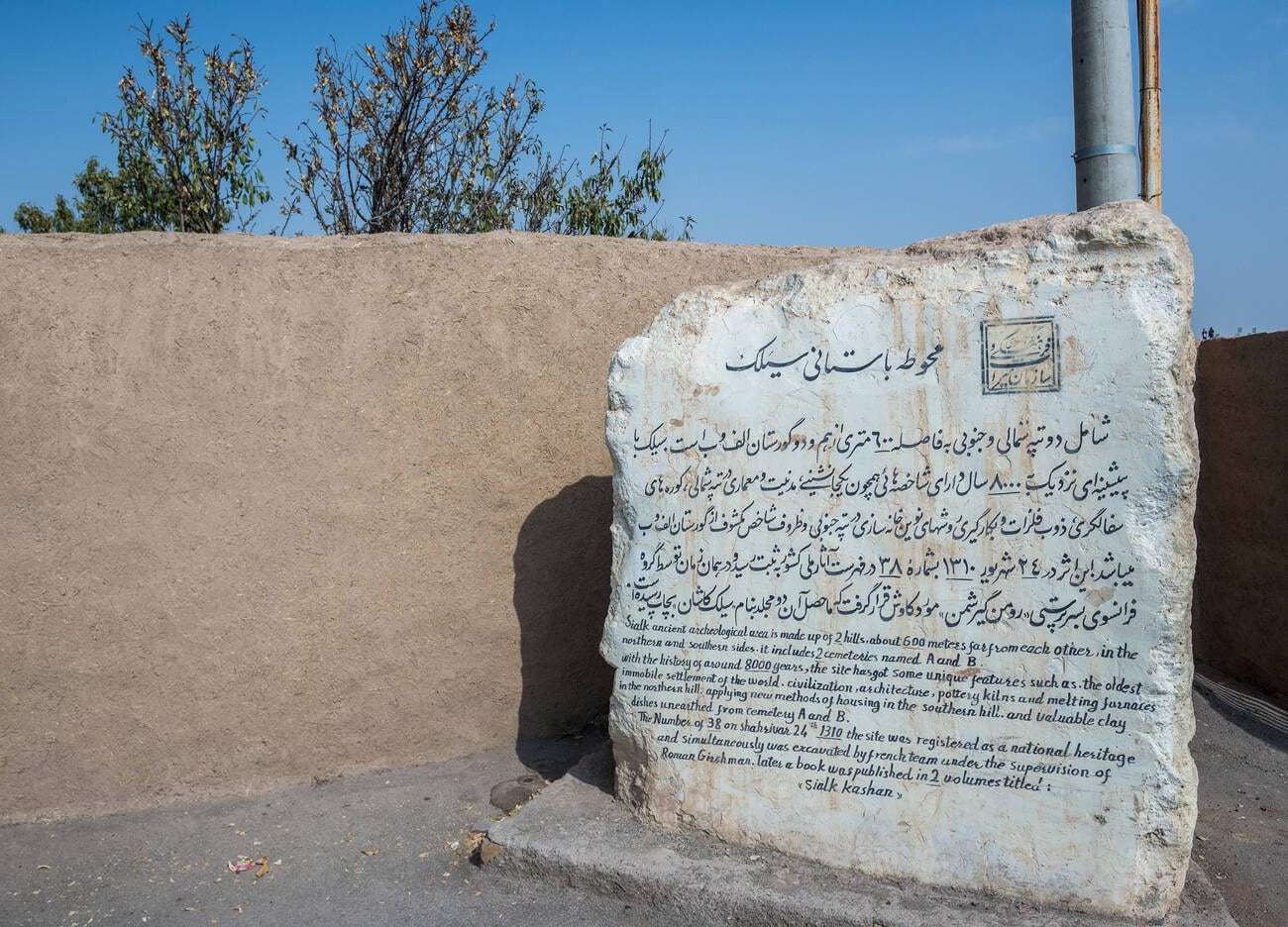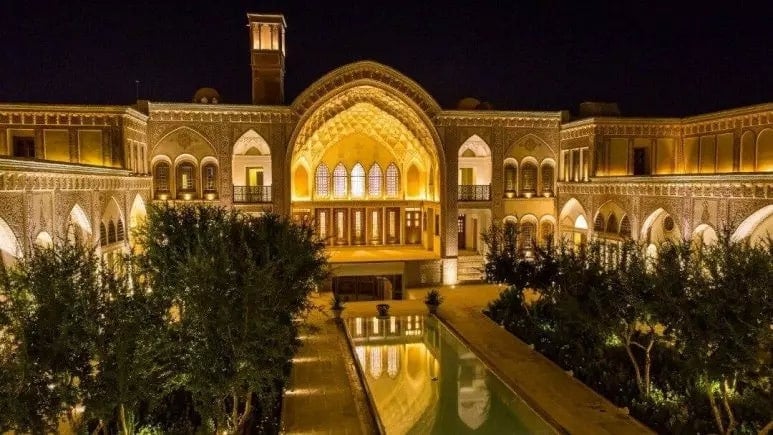Tepe Sialk: A Journey Through Millennia
Unraveling the Mysteries of an Ancient Iranian Treasure

Sialk is the name of the first civilization in central Iran, located in Kashan. The ancient site of Sialk, situated in the Fin area of Kashan, dates back over eight thousand years. This mound is actually the ruins of an ancient ziggurat in Iran.
Nearly eight thousand years BC, cave-dwelling people of the Iranian plateau, facing climatic changes and the formation of farms and meadows, turned to the plains and started a new life.
In their civilization, more progress was seen compared to previous eras; the oldest people of the plain-dwelling were the people of the Sialk area near Kashan, whose life traces have been found there. Sialk is one of the important archaeological sites of the Iranian plateau, where one of the oldest settlements of central Iran was established around more than seven thousand and five hundred years BC.
Contents
Archaeological Significance

Tepe Sialk, a prominent archaeological site in Iran, stands as a gateway to understanding the ancient civilizations that once flourished in the region. Dating back to the 4th millennium BC, this site near Kashan is a treasure trove of historical insights, drawing researchers and history enthusiasts from all corners of the globe.
The significance of Tepe Sialk lies in its rich layers of history, each unearthed through meticulous excavations that began in the 1930s. These explorations have revealed an array of artifacts, including pottery, tools, and remnants of early architecture, offering a window into the lives and cultures of its ancient inhabitants.
The architecture of Tepe Sialk is particularly fascinating, showcasing the evolution of early urban development. From simple mud-brick houses to more complex, organized structures, the site illustrates the advancements in construction techniques over centuries.

These architectural findings not only provide insights into the practical aspects of ancient living but also reflect the societal organization and cultural practices of the time.
Beyond its structural marvels, Tepe Sialk is a cultural beacon. The diverse artifacts unearthed here, ranging from intricately designed decorative items to utilitarian tools, paint a vivid picture of everyday life in ancient times. These discoveries offer glimpses into the social, economic, and artistic dimensions of the site’s past inhabitants, contributing to a deeper understanding of their lifestyles and interactions.
The Story of the Discovery of Tepe Sialk

Tepe Sialk was discovered by chance, which is one of the most astonishing aspects of its history. Until about 80 years ago, no one knew that such a historical treasure even existed. A treasure that is the legacy of a great civilization spanning several thousand years. Even the people of Kashan believed that the area where Tepe Sialk is located was cursed. However, a severe flood changed everything. This flood exposed several graves, tools, and pottery buried in the area.
When opportunists realized this, they wanted to get rich overnight, bypassing centuries of history. Therefore, they began to plow the lands of this historical site. They sold the antiquities found in this area at meager prices to dealers and smugglers. This led to the antiquities of Tepe Sialk being taken out of the country and ending up in western museums, including the Louvre Museum in Paris.
Roman Ghirshman, an archaeologist from the Louvre Museum, decided to come to Iran and save this historical site after seeing these antiquities. With the help of André Godard, the director of the National Museum of Iran, they began extensive excavations in the area and published the results in several parts.
Unfortunately, Ghirshman and his colleagues did not make much progress, and the condition of Tepe Sialk was increasingly leading towards destruction. If Dr. Sadegh Malek Shahmirzadi had not appeared, probably nothing would have remained of this hill, and its place would have been taken by residential houses, agricultural lands, and roads.
From 2001, Dr. Shahmirzadi, along with a professional team, began archaeological operations in the area and published any information they obtained from this region in five volumes over the next five years.
Excavations and Discoveries

The excavations and discoveries at Tepe Sialk have profoundly enhanced our understanding of ancient civilizations in Iran and beyond. This archaeological site, dating back to the 4th millennium BC, has been a focal point for historians and archaeologists, revealing layers of human history buried beneath its soil. The meticulous excavations, which began in the 1930s, have unearthed a wealth of artifacts and structures, each telling a unique story about the people who once inhabited this region.
One of the most significant aspects of the discoveries at Tepe Sialk is the variety and richness of the artifacts found. These range from beautifully crafted pottery, which reflects the artistic sensibilities of the era, to everyday tools that offer insights into the daily lives and occupations of the site’s ancient residents. Each item discovered provides a crucial piece of the puzzle, helping historians reconstruct the social, cultural, and economic fabric of the times.

The architectural remnants uncovered at Tepe Sialk are equally telling. The site showcases a remarkable transition in building styles and techniques, from rudimentary mud-brick structures to more sophisticated and organized forms of architecture.
This evolution is indicative of the societal changes and technological advancements over time. The layout of the settlement, the construction methods used, and the design of individual buildings all contribute to a deeper understanding of the community structures and lifestyles of the ancient inhabitants.

Beyond individual artifacts and structures, the overall stratigraphy of Tepe Sialk has been instrumental in providing a chronological framework for the region’s history.
The different layers of the site correspond to various historical periods, each with its distinct characteristics and artifacts. This stratification has allowed archaeologists to construct a more detailed and nuanced timeline of human occupation and activity in the area.
- Initial Excavations: Conducted in 1933, 1934, and 1937 by Roman Ghirshman and Tania Ghirshman.
- Recent Studies: Resumed between 1999 and 2004 by a joint team from the University of Pennsylvania and Iran’s Cultural Heritage Organization, led by Sadegh Malek Shahmirzadi.

Notable Findings
- Artifacts: Exquisite painted pottery, now housed in prestigious museums like the Louvre, the British Museum, and the National Museum of Iran.
- Northern Mound: Dating back to the end of the 7th millennium BC, showcasing early architecture and pottery.
- Southern Mound: Reveals the progression of architecture, crafts, and metallurgy, dating back to the 5th millennium BC.
How to visit Silak Tepe?
Tepe Sialk is located near Kashan, Iran. First, you’ll need to arrange travel to Iran, typically through Tehran, the capital. From Tehran, you can travel to Kashan by bus, train, or car. The journey takes about 2 to 3 hours. From Kashan you can take a local taxi to go to the tepe.
What are the visiting hours for Tepe Sialk?
This site is open to tourists and visitors every day from 09:00 AM to 05:00 PM.
Final Words
In summary, Tepe Sialk stands as a remarkable testament to the ancient world. Its accidental discovery opened a window into a civilization rich in history and culture. The site’s artifacts and architecture reveal a past marked by innovation and resilience.
Pioneering archaeologists like Roman Ghirshman and Dr. Sadegh Malek Shahmirzadi played key roles in uncovering and preserving these treasures. Today, visitors to Tepe Sialk journey through layers of human history. Each layer tells a story of progress and survival.
This site is not just a historical landmark; it is a beacon of knowledge for future generations. Tepe Sialk reminds us of our shared past and the unbroken thread of human ingenuity that connects us all.





